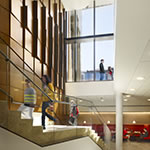
Large windows and stairs made from Jerusalem stone, which is light in color, help brighten the below-grade portions of Golkin Hall. Photo: Barry Halkin
The physical experience of Golkin Hall, the new law school building at the University of Pennsylvania in Philadelphia, involves plenty of natural light and green space. The building has four green roofs, two of which allow public access, and a central, four-story staircase that is bathed in direct and indirect sunshine by day.
What makes this so significant is the fact that a large portion of the building is underground. Its pleasantness is the remarkable accomplishment of its design, by Kennedy & Violich Architecture (KVA) of Boston. The 41,315-square-foot structure replaces a building nearly one third its size, and if this feat wasn’t already challenging enough, the designers agreed that an open area adjacent to the building—a grassy quad on its north side—was too popular a hangout to inadvertently shade with a taller structure.
“The heart of the law school campus is its courtyard,” explains Frano Violich, a principal at KVA. “We had to balance the size of the building against shading this open space.”
The only option was to go below the surface. This included a 350-seat auditorium, a moot court room, and the student center, all below grade. Because the building largely runs along an east-west axis, it was able to draw natural daylight from its south-facing façade with a floor-to-roof glassed entryway and a corresponding opening in the rear. The main staircase—surfaced with light-colored Jerusalem limestone, which boasts a hardness equivalent to granite—brings light to the subterranean-level circulation area. “When below the surface, you can still see buildings on the street,” Violich says. “It’s a sleight of hand, creating the illusion of being on the ground level when you are not.”

Because of innovative window use, light can penetrate all the way to the subterranean levels of Golkin Hall. A glass façade lets light seep in through the atrium entryway and open stairwell, which leads to the lower level.

This building also was expected to communicate something about Penn Law’s goal to create a legal education based on interdisciplinary scholarship and transparency. This contrasts with historical judicial architecture, made up of imposing buildings with rock-solid façades and neoclassical elements such as pillars and pediments. In fact, the new building connects to Silverman Hall, a very large, ornate neo-Georgian structure built in 1900 (also part of the law school), but the KVA design upends these traditional notions with a campus- and street-friendly, LEED Gold structure that accomplishes multiple objectives.
Signature elements of this modern openness are the entrance windows and stairwell, but a marble-panel exterior wall to the east of the main entrance acts more as a sunlight sieve than a barrier. All panels align at the top, but as it gets closer to the ground, half the panels progressively rotate to approximately 90 degrees. The effect is that morning sun dapples the entryway with a type of light sculpture. “We can rethink architecture,” Violich says of this unique solution. “Hard materials can be used in a softer way.”

The undulating brick and marble around the building’s windows add texture and depth to the exterior. “We can rethink architecture; hard materials can be used in a softer way,” says project architect Frano Violich. Photo: Barry Halkin

AHA Consulting Engineers helped achieve Golkin Hall’s LEED Gold certification by installing a high-efficiency HVAC system and an energy-recovery wheel. Photo: Barry Halkin
The entry doors and windows are deeply indented, as are all south-facing fenestrations, to minimize solar heat gain in the summer. This is part of an integrated approach to energy efficiency—which includes envelope design, glazing systems, mechanical and electrical systems, occupancy sensors, LED lighting, and enthalpy economizers—to achieve 32 percent less energy use than code standards.
The multi-terraced roofs of the building, which are stepped to allow sunshine in the courtyard, are also covered in vegetation (sedum and grass species), wood decking (as walkways, seating, and gathering spots), and white membrane near mechanical systems to reflect heat. Together with pervious pavements, these surfaces reduce stormwater runoff by 52 percent. With public spaces on the roofs, the courtyard is effectively extended and elevated. “Sustainability is also about promoting social interaction,” Violich says. “We increase the quality of life when we can create these human experiences.”

